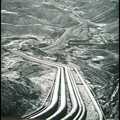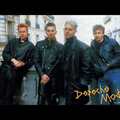Prejudices. We all have a few. Gareth Jones hated pop groups like Depeche Mode back in the early ’80s. After working with John Foxx on his seminal minimal synth album Metamatic, he felt he could make a living outside of the normal channels. But after he was finally convinced to meet the group by Foxx himself, Jones was won over. Depeche and Gareth Jones went on to create some of the most adventurous pop music ever made, and it all started on that first album with a tune called “Pipeline.”
Depeche Mode were trying to make album number three and were looking for a studio. John Foxx, being an electronic musician, they thought, “Let’s go and work in John Foxx’s studio.” They didn’t like rock ‘n’ roll, it was electro-pop that Depeche were trying to make.
Now, the thing about Depeche was that they were on the radio. I didn’t think that was a very good place to be. I didn’t think that was very cool. I was more interested in stuff that wasn’t on the radio. I was working at John’s studio at the time and I just thought, “It’s pop music, I don’t wanna be involved.” So they came to check out the studio and I said to John, “I’m not doing the session, it’s a pop band, it’s not my thing, there’s no point, I don’t get it.” He said, “You’re making a mistake, Gareth, it’s something you need to be involved in.” “Oh fuck off, don’t boss me about, tell me what to do.”
“I realized I hadn’t got the tape recorder switched on right, which was a bit embarrassing.”
So they came to check the studio out for the weekend with another engineer who was there. They liked the studio, but they didn’t like the engineer much. So the universe kindly gave me a second chance. John came back to me and said, “Gareth, I’m telling you, go over there and see what happens.” So I was, “Oh all right, John, if I have to.” So I went over to this tiny little office, Mute Records at that time, and met this band and [label head] Daniel Miller.
I’d been in Morocco for a month, hanging out, smoking pot. I had on this Moroccan jacket and black nail varnish and went over on this bicycle. Funnily enough they seemed to be like normal human beings, they seemed all right. They obviously thought I was all right, because we decided… or they hired me, I suppose. “We decided” plays my role up a bit too much really. But I thought, “Oh they’re all right, actually. They might be doing pop music but it’s not that bad. They seem all right, quite nice. Daniel seems a bit weird,” I thought. “But there you go.” They probably thought the same about me.
 So we started working together and made Construction Time Again. It was recorded in John’s studio in Shoreditch, The Garden. This was the early ’80s, and sampling had just been invented. It was mind-blowing, ’cause you could take sounds like that [knocks glasses on water jug] and put them in the machine and play beats and melodies with them. I know this is totally obvious, but I’m trying to give you some idea of what that was like for us. It was incredible. Suddenly everything changed.
So we started working together and made Construction Time Again. It was recorded in John’s studio in Shoreditch, The Garden. This was the early ’80s, and sampling had just been invented. It was mind-blowing, ’cause you could take sounds like that [knocks glasses on water jug] and put them in the machine and play beats and melodies with them. I know this is totally obvious, but I’m trying to give you some idea of what that was like for us. It was incredible. Suddenly everything changed.
So we made a track called “Pipeline” all with samples. We went out into a scrapyard in Shoreditch, disused railway lines. We went out with two tape recorders and microphones. I had a beautiful analogue reel-to-reel tape recorder, Stellavox, beautiful Swiss thing. We went all round this scrapyard for a couple of hours and sampled all these sounds. Close mics and distant mics. Then we got back to the studio with these sounds and I realized I hadn’t got the tape recorder switched on right, which was a bit embarrassing, so they all sounded shit. So we had to go out again and do it all again, but we were very motivated by this idea of constructing a track by using found sound. It’s readymade, it’s Marcel Duchamp in sound.
There’s this really interesting article with Matthew Herbert about how he made a record from a pig. All the sounds are from the pig, from the moment of its birth right up to the moment of being eaten. I haven’t heard the record, but the concept is wonderful. He said one of the things he finds quite hard with found sound is getting any sense of pitch. Funnily enough, when I was using samplers there’s lots of pitch. [knocks on table] There’s pitch. [knocks on speaker] There’s even pitch in the speakers. In a scrapyard there’s lots of sounds with pitch: bell sounds, metal sounds.
So after I’d admitted my mistake and apologized, we went back out and sampled everything again. We mixed the close and distant sound into these very primitive early samplers that would play only one sound at a time. Most of the time we couldn’t store the sounds, so it would be played, recorded onto tape, then the sampler would be emptied and we’d put a new sound in. The whole track is made with sampled sounds.
Incidentally, the track has no EQ or reverb. When we got to Berlin and mixed this track, we’d spent so much work on the other mixes and compression and EQ and everything that I was just totally burned out. We put this one up on the faders, and it just sounded great. So I suggested, as a concept, we mix it without any reverb or compression or EQ. Found sound in its actual state.




